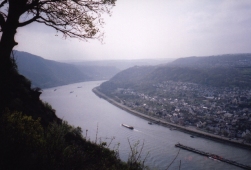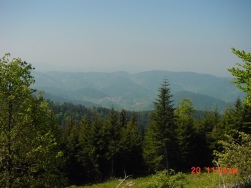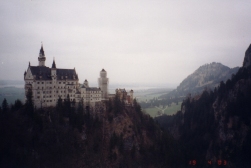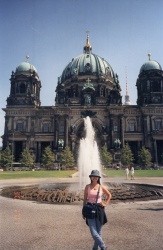 Living right next to this giant neighbour for Holland, it was inevitable that we would make journeys, some short and others a little longer.
Living right next to this giant neighbour for Holland, it was inevitable that we would make journeys, some short and others a little longer.
Aside from a package tour in 2001 where we started in Frankfurt, spent little time in Berlin and Rothenburg, our journeys were road trips that took us to some of the nooks and crannies of the country.
Perhaps not all of it though, afterall it is not a small country either.
However unlike France, we did not engage in a deep exploration. Part of that comes from the bias we have that Germany unlike France, do not have as much of preserved history. Of course this is not true and this is evident from the many road trips we made over the course 3 years. In fact the history of Germany is very intriguing.
Home to more than 300 princely states in the middle ages, the country was not one until 1871. Each state that makes up the country has very unique sub-cultures. Just as much as there are many dialectic languages in China, so it is the same in Germany and a Bavarian might not make sense what someone from the Friesland north says, unless they converse in the “common language” – high German that is.
Rhineland and the west
Proximity means that it is the first part of Germany that we reach when driving across the porous borders. Nowhere it is said that there is such a concentration of medieval castles that is along the Rhine river.

In the middle ages, the Roman roads had all but deteriorated and crossing great distances was usually made by way of river traffic. People, goods and ideas flowed along the great rivers of Europe and one of them was the mighty Rhine that would eventually empty its waters into the north sea outside the estuaries close to Rotterdam.
We saw the river and strongholds that line them both from water and land. Today it is still very popular to follow the direction of the river as its brings you to cities that had grown on the flow of trade and industry over a millennia.
Why so many castles and fortress strongholds were built here should be obvious – the protection of territory and the exaction of toll on the traffic that patronize the use of the waterway. Staying in a castle is obviously one experience, and we definitely share how it felt like here (coming soon).
But castles and strongholds were not the sole domain of the Rhine, for they can be found all over Germany. Most were built by the local ruling noble families, both secular and ecclesiastical (yeah there were plenty of princely bishops). Over time some of these grew into cities and one of the most beautiful we have visited was Heidelberg.
Moselle, Alsace & Lorraine
Not many people know that Germany makes good wine too and it is the sweet Riesling we are referring to. Sure it is not for most main courses but good as a dessert wine in our view. In the valley of the Moselle river, there is a slip of the country where this species of grape was cultivated intensely.

The middle ages was also a time of great turmoil, as the dynastic nobility treated the land (and its people) as their personal property to be utilized, mobilized and extracted as they wish. The great families that ruled over what is today France and Germany constantly battled for supremacy and territory.
For that we turn to the region in between both countries (it belongs to France now) that is Alsace and Lorraine. Technically it is part of the political territory of modern France, stories of our handprint to these locales are parked under France. But for a long time this was a contested and coveted land. Though now part of France, you will no doubt read from our stories that many towns and villages retain German sounding names.
The Black Forest
Yet another famed region of Germany must be the black forest.
The dense forests of the region make a good setting for cartoons and movies depicting the abode of witches and all imaginary beings (pixies, fairies etc). Perhaps some can play Pokemon Go there…Seriously though, some Germans are known to like living in the forest and their little villages can be found in these mountainous region. Hiking and trekking seem to be serious pastimes for these folks as we found out over the weekends.

We found a village (Lauterbach) where we would stay a night while doing the Cuckoo clock driving circuit. Yes, this area is also renowned for making some of the best clocks – said to be since the 1700s. You know, we were told that if we had US Military IDs, we could have gotten even more discounts. Will Singapore military ID do??? Unfortunately not at this point. Sigh.
One thing we did not try was the many spas that we found along the road trip.
It should be noted that driving in the small roads can be risky and with the bends and curves, you might not see oncoming traffic. Close calls with large campervans and RVs were quite normal! But stepping off the highways to the small villages does have its rewards.
The South
Definitely a must check-off destination in Germany must be the southern state of Bavaria. Perhaps Munich would be more specific.
As one of the largest component of the German confederation (we’re talking pre world war days here), the state was governed by a King in its own right. Rumor has it that this is also one of the wealthiest part of Germany. As its capital, Munich boasts of many palaces well preserved or restored to its former glory.

The history of this state makes for good comparison with the Star Wars story. Just like the Galactic republic in which a council of representatives from the various states (planets in the movie) elected a leader, Bavaria was an influential state due to its geographical location and size. Its princely elector was an important voter on the diet that decided who became Holy Roman Emperor.
For us the highlight though was not these palaces and political intrigues, but the fairytale castle of Neuschwanstein. If you’ve been to Munich but not to this castle, then you have really missed the big time. Built at a cost of 6.2 million marks in those times, it bankrupted a King who amassed a massive amount of debt to satisfy his penchant for a refuge to call his own. Today it receive thousands of visitors though we have to say it is probably a better deal to seek high ground to take its exterior pictures than the interiors.
You’re from the East?
Herein is the gap. The Eastern side of Germany was opened up in the mid to late 90s after the fall of the Berlin wall. For a long time (and still progressing), the East is still being integrated with the western side of the country. Our forays to this part of Germany was mostly fleeting, in the form of package tours making a whirlwind series of stops on the way onto other countries.

On one occasion, we stopped by the Pomeranian coast at a small town of Puttgarden to board a ferry for Denmark. While on another we stayed for a day in Berlin. The capital of the country was undergoing a lot of change at the time of our visit, barely just over 10 years from reunification. And that was still the days of using deutschmarks.
How time has flown past in an instant. Recalling such memories and the stories we picked up in those days from our travelogues really refreshed our recollections of events past. The eastern half of Germany holds just as much historical and cultural secrets as the west and perhaps someday we will be back again to dig out those treasures.

Your comment about my Brandenburg post brought me here 🙂 The German countryside looks breathtaking
LikeLiked by 1 person
Oh yes. And in a couple of months we shall start our German series of stories from our past handprints!
LikeLiked by 1 person